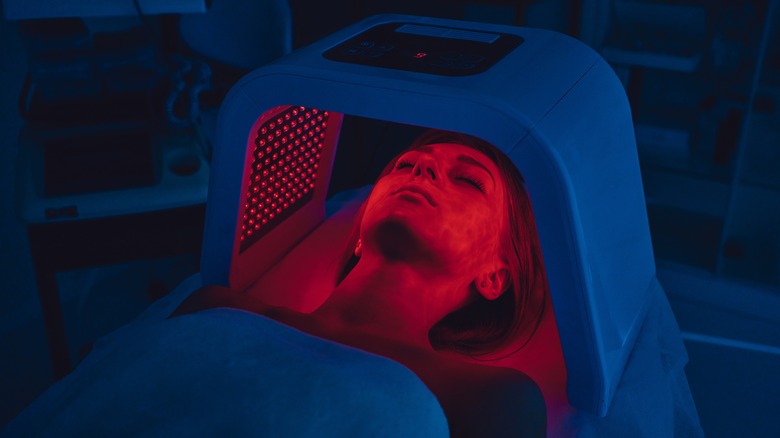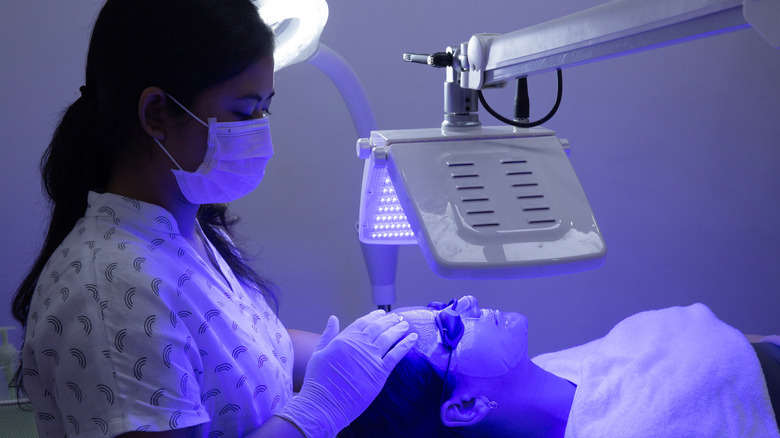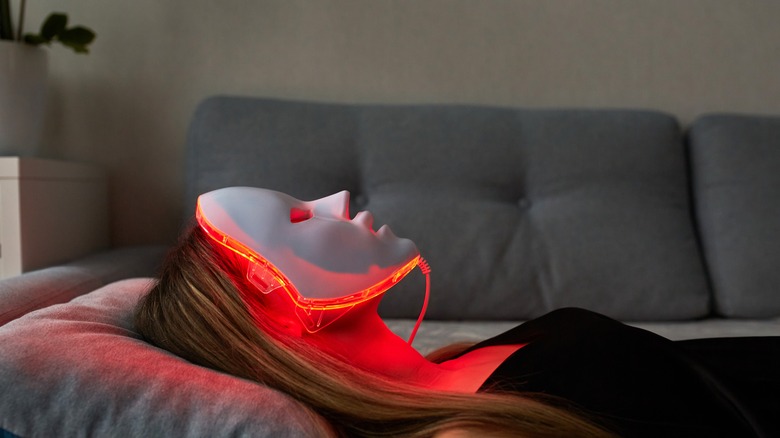Blue Vs. Red Light Therapy: What Each Acne Treatment Actually Does
Acne can be frustrating, especially if you've already tried every treatment available. From liquid pimple patches to anti-fungal sprays, and from topical antibiotic creams to oral medication, people have been trying to battle acne since forever. Aestheticians and dermatologists are our trusted allies in this battle, and as technology and medicine evolve, new therapies are added to our arsenal.
Enter phototherapy, a new method that seems to be rising in popularity. Phototherapy uses light therapy — including blue and red light therapy — to treat skin conditions, including acne and aging concerns. As Mayo Clinic dermatologist Dr. Dawn Davis explains, "Every color of the rainbow has a different wavelength of light. And we have found, through research in dermatology, that certain visible light colors, when they are concentrated and intensified, can have some benefit to the skin."
Blue light therapy, in particular, is used by dermatologists to treat persistent acne by targeting the bacteria on our skin,while red light therapy encourages a boost in collagen and circulation to improve the appearance of the skin overall. Meanwhile, both forms of phototherapy "may reduce the size of the sebaceous glands, so you don't produce as much oil," explains Dr. Hooman Khorasani of the Icahn School of Medicine at Mount Sinai, per The Strategist. According to the results of a 2019 research article published in the Annals of Family Medicine and 2021 research published in the Journal of Cosmetic Dermatology, both blue and red light therapy may be as effective as traditional acne therapies — though more research is needed.
Blue light therapy vs. red light therapy
While blue and red light therapy are both useful for skin compromised by acne, they work in slightly different ways. As dermatologist Dr. Gloria Lin told Elle, "Blue light has anti-microbial properties, which can be helpful when dealing with acne since it is associated with a particular bacteria (C.acnes). This particular species produces a substance called porphyrin that will absorb the blue light and, through a chemical reaction, can destroy the bacteria." Blue light also has anti-oxidizing effects on our skin since it attacks free radicals. Plus, it helps reduce inflammation from acne.
On the other hand, red light therapy does not have the same effect against acne-causing bacteria, but it does help with inflammation and scarring. Red light also has some anti-aging properties as the wavelength of the red light encourages our body to produce more collagen, which in turn helps our skin look younger and healthier. "It's a pain-free, relaxing experience with no downtime, making it an ideal choice for those seeking effective skin solutions without invasive procedures," cosmetic aesthetics doctor Ed Robinson, M.D., told Healthnews. "It's not going to have the same effect as, say, injectables, but its fantastic safety profile makes it a great adjunct to an anti-aging regime."
Are DIY phototherapy devices any good?
A quick online search will show that light phototherapy DIY devices are becoming increasingly popular as a way to combat stubborn acne. "There are a number of small trials that have shown modest efficacy for these at-home devices [at improving acne], mostly ranging from 30 to 50% improvement," Dr. Hooman Khorasani told The Strategist. "Benefits can usually be seen as early as a few weeks ... But there are no robust clinical trials comparing these devices head-to-head or to other acne treatments."
So, is DIY blue and red light therapy worth the hype after all? A 2009 study published in The Journal of Clinical and Aesthetic Dermatology on the efficacy of at-home blue light therapy suggests that participants were pleased with the overall results. Granted, it's a cheaper alternative to getting professional phototherapy treatments, and several products are even recommended by professionals. Another advantage is that some devices combine both blue and red light. There are entry-level devices available for those on a budget, as well as those that cost upwards of $400. While the cheaper alternatives allow you to reap some of the benefits of phototherapy for a fraction of the price, Dr. Ed Robinson explained to Healthnews that budget-friendly options "for $300 or less" may not provide the same results. Once you've found a device that works for you, Dr. Gloria Lin advises using it consistently and taking precautions to protect your eyes, per Elle: "Eye protection is key with the light therapy, even with the at-home devices, as improper use can lead to issues with the eyes and skin."


